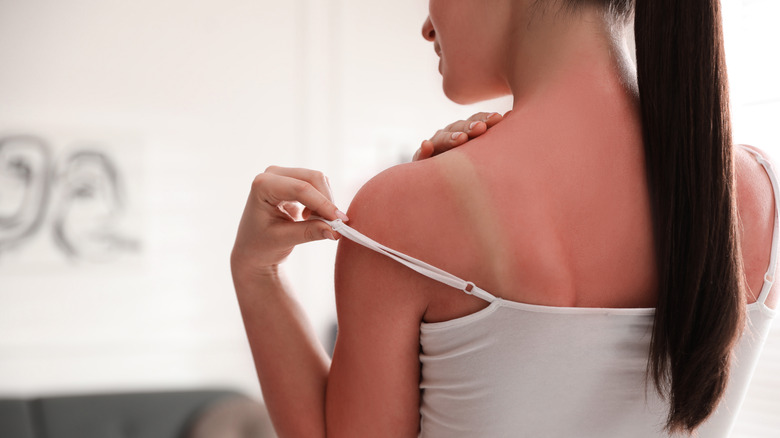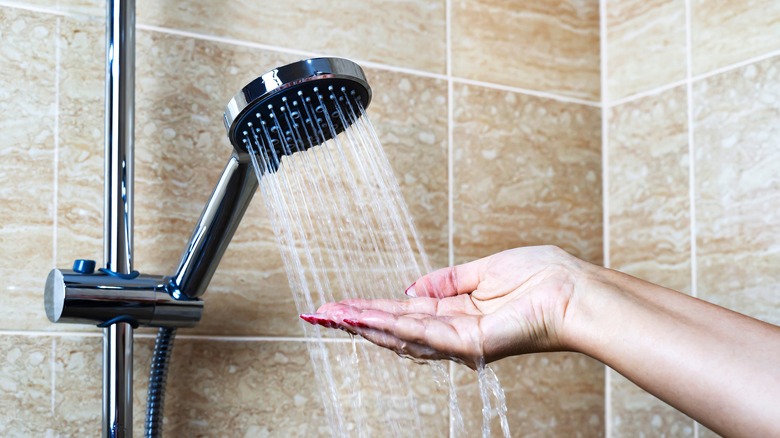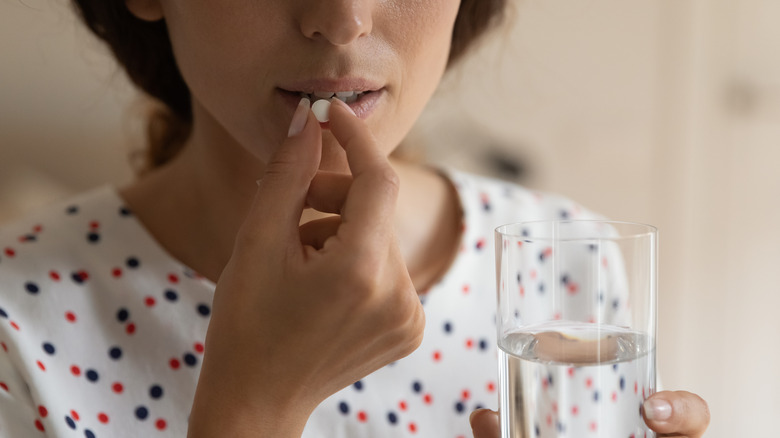Taking A Cold Shower Might Be The Best Remedy For A Bad Sunburn
We may receive a commission on purchases made from links.
Don't fall asleep at the beach this summer. That is, unless you're in the shade, covered head to toe in sunscreen, and wearing a hat. Over 30,000 people visit the emergency room yearly due to a particularly-bad sunburn, according to the National Cancer Institute). Not only that, but approximately 33% of us will report at least a minor sun damage this year, per HHS.gov. Even when we're not in direct sunlight, we're putting our skin at risk. It may sound alarmist, but it's true.
"I advocate using an SPF product every morning, because during the course of your daily activities, you may be getting what's called 'inadvertent sun exposure,' either when driving (through window glass) or from a short errand outdoors that turns into more exposure than planned, like if you run to the mailbox and stop to talk to a neighbor," dermatologist Loretta Ciraldo, M.D., warns Everyday Health. The ears, scalp, hands, and lips are often overlooked when it comes to SPF. It's best to reapply sunscreen every two hours, especially if you've been splashing in the pool or ocean. So, how much sunscreen do you really need? You should be applying between ⅓ and ½ teaspoons on your face alone — it may take a while to absorb, but it's well worth it. A shot glass worth of SPF should do the trick for the rest of your body, Healthline suggests.
If you do fall asleep outside or start to feel yourself turning red while behind a wheel, something as simple as a cold shower could be just what you need.
A cold shower will relieve the pain
Sunburned? Turn on a cold shower. "Cool water decreases excess blood flow to the skin, which will help reduce inflammation and redness," Kavitha Reddy, M.D., explains to Men's Health. The water will also temporarily relieve pain. While you're rinsing off, steer clear of soaps, especially if they're scented or exfoliating. These can strip your skin and lead to further discomfort.
If you're more of a bath person, add a few tablespoons of baking soda to lukewarm water and soak for a good 20 minutes. A known treatment for eczema, this pantry staple can also help relieve some of the itchiness and inflammation associated with sunburns. Speaking of pantries, colloidal oatmeal also has helpful anti-inflammatory and antioxidant properties — add a few generous scoops to your bath water. You can buy a pre-made colloidal soothing treatment from Amazon, or make your own with dry oatmeal and a food processor.
Once you're done bathing, gently dry your skin with a soft towel. Scrubbing will only serve to irritate the affected area further, so use your best judgment. Next, apply unscented moisturizer to your burns — keep in mind that slightly damp skin will better absorb products. Finally, drink a big glass of water and try not to get any more sun.
Over-the-counter medication can reduce inflammation
Is your sunburn red, hot, or painful? Buy an anti-inflammatory at your local pharmacy — ibuprofen or aspirin should get the job done. What's more, if you catch the sunburn while it's still at an early stage, over-the-counter medicine can prevent the burn from getting worse.
Topicals like aloe vera gel and hydrocortisone cream are two of the best ways to heal a sunburn. "If possible, use [aloe vera] gel straight from the plant itself," New York-based dermatologist Dr. Marie Hayag advises Insider, adding, "Cut open the plant leaves and squeeze out the clear gel inside." However, she goes on to warn against using too much, as aloe vera gel also has exfoliating properties. If you're investing in a store-bought aloe vera lotion, make sure it doesn't contain any added fragrances.
Once your sunburn begins to blister, it's time to practice some self-control. However tempting it might be, don't pop or pick at the bubbles that appear on the surface of your skin. This can lead to infection, even more pain, and long-term scarring. As your skin starts to peel, continue to moisturize and take precautions to prevent further burning.


